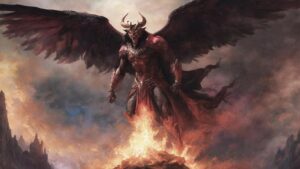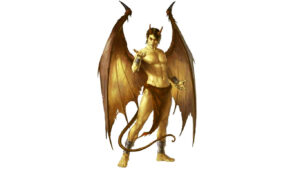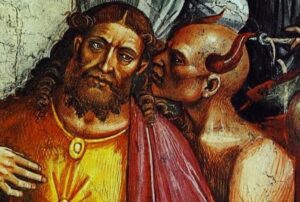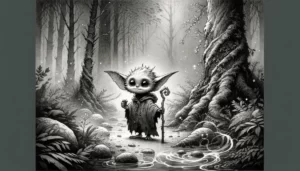Table of Contents
Who is Astaroth?
Mythological and Historical Origins: In ancient mythology, Astaroth was originally a goddess of fertility and love in ancient Phoenician religion. The name Astarte or Ashtoreth is often associated with this goddess.
Demonology: In demonology, particularly within certain grimoires and medieval occult texts, Astaroth is depicted as a male demon. In the “Ars Goetia,” a section of “The Lesser Key of Solomon,” Astaroth is described as a powerful and grand duke of Hell. This demon is said to command forty legions of demons and is associated with knowledge and secrets.
Cultural References: Astaroth has made appearances in various cultural and literary works. In some cases, the character has been portrayed as a demonic force, embodying themes of temptation, knowledge, and the occult.
The interpretation of Astaroth can differ widely, ranging from ancient mythological goddess to a demon in later occult traditions. Additionally, beliefs and perspectives on Astaroth may vary among different religious and cultural contexts.
Knowledge of Astaroth
Historical and Mythological Origins: Astaroth has historical roots, initially associated with the Phoenician goddess Astarte or Ashtoreth, a deity linked to fertility and love.
In Demonology: In later demonological texts, particularly in grimoires like “The Lesser Key of Solomon,” Astaroth is depicted as a male demon. Astaroth is often listed as a grand duke of Hell and is associated with knowledge, secrets, and sometimes depicted as a teacher of the liberal arts.
Attributes and Associations: Astaroth is sometimes linked to themes of knowledge, truth, and the imparting of hidden wisdom. The entity is portrayed as having the ability to reveal information about creation, the fall of angels, and other esoteric subjects.
Ambiguity and Interpretations: The character of Astaroth is subject to varying interpretations within different occult traditions. Some portray Astaroth as manipulative, using knowledge to lead individuals astray, while others view Astaroth more sympathetically as a misunderstood or unjustly judged entity.
Cultural and Occult References: Astaroth has appeared in various occult and mystical texts, often discussed in the context of summoning rituals, demonology, and esoteric practices.
Need to emphasize that beliefs and interpretations of Astaroth vary widely among different esoteric and occult traditions. Additionally, the narratives surrounding Astaroth are not part of mainstream or major world religions. The information provided here is a general overview, and specific beliefs and details may differ among practitioners of various esoteric paths.
Physical Appearance
Descriptions of the physical appearance of Astaroth, as with many entities in demonology and occultism, can vary among different sources and traditions. In general, depictions of Astaroth may include symbolic or allegorical elements rather than a literal, physical representation. Some common symbolic associations:
Humanoid Form: Astaroth is often described as manifesting in a humanoid form. This form may include both male and female characteristics, emphasizing Astaroth’s duality or ambiguity.
Crowned or Adorned: Some depictions show Astaroth wearing a crown or being adorned with symbols of authority, reflecting the entity’s status as a grand duke of Hell.
Animal Symbolism: Symbolic connections to animals may be present. For example, Astaroth is sometimes associated with snakes, reflecting themes of temptation or hidden knowledge.
Artistic Interpretations: Artists and occultists may provide their interpretations of Astaroth’s appearance based on their own beliefs and traditions. These artistic representations can vary widely.
Depictions in Occult Texts:
In some historical occult texts, illustrations or descriptions of demons, including Astaroth, may be included. These depictions often carry symbolic significance rather than attempting to provide a realistic portrayal.
It’s essential to note that the physical appearance of entities in occultism is often approached symbolically, representing aspects of the entity’s nature or role rather than a literal description. Different occult traditions and practitioners may have diverse interpretations of Astaroth’s appearance, and artistic representations can be highly subjective. Additionally, beliefs and descriptions can evolve over time within esoteric communities.
Astaroth in Other Cultures
Astaroth, Astarte, Inanna, Ishtar, and Isis are figures from various mythologies and religious traditions:
Astaroth: In demonology, Astaroth is often depicted as a male demon associated with knowledge and secrets. However, the name has historical roots in the Phoenician goddess Astarte.
Astarte: Astarte is an ancient Phoenician goddess of fertility, love, and war. The worship of Astarte spread to various cultures in the ancient Near East.
Inanna: Inanna is a Sumerian goddess of love, fertility, and war. She was later associated with the Akkadian and Babylonian goddess Ishtar.
Ishtar: Ishtar is a Mesopotamian goddess of love, beauty, sex, desire, fertility, war, and justice. She is a prominent figure in the Babylonian and Assyrian pantheons.
Isis: Isis is an ancient Egyptian goddess associated with motherhood, magic, healing, and protection. She was considered a powerful and benevolent deity in Egyptian mythology.
While these figures may share similarities, they originate from distinct cultural and mythological contexts. Astaroth’s association with demonology contrasts with the benevolent and revered roles of Astarte, Inanna, Ishtar, and Isis in their respective cultures.
Sstaroth sigil
If you’re looking for a specific sigil associated with Astaroth, it’s recommended to consult reputable occult sources, grimoires, or the specific tradition or system of magic you are following. Some occult practitioners prefer to create their own sigils through personalized rituals or methods.
Please note that the use of sigils and practices associated with demonology or occultism should be approached with caution and respect for individual beliefs. Interpretations and practices can vary widely, and it’s essential to engage in such activities with a thorough understanding of their cultural, historical, and symbolic contexts.




